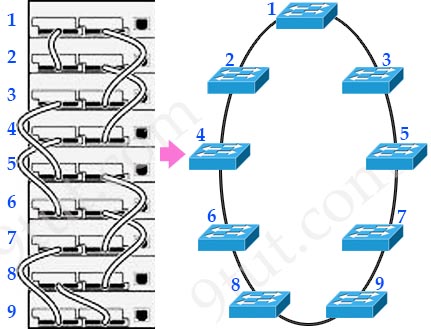Switch Stacking & Chassis Aggregation
Question 1
Explanation
Switch stacking technology allows the network engineer to make that stack of physical switches act like one switch. The stacking cables together make a ring between the switches. That is, the switches connect in series, with the last switch connecting again to the first.

Answer B is not correct as switch stacking is about connecting switches together so that they act as one switch, not about adding and removing hosts.
Answer C is not correct because switch stacking has nothing to do with performance of high-needs applications.
Surely switch stacking provides redundancy as stacking creates a ring of connection with two opposite paths. Whenever a frame is ready for transmission onto the path, a calculation is made to see which path has the most available bandwidth. The entire frame is then copied onto this half of the path.
With switch stacking, STP, CDP and VTP would run on one switch, not multiple switches. Also there would be one MAC address table, and it would reference all ports on all physical switches so we may say switch stacking has better resource usage. Also if we consider all stacking switches as one logical switch then surely the port density is increase very much. Therefore answer D is the most suitable one.
Question 2
Explanation
Chassis aggregation is a Cisco technology to make multiple switches operate as a single switch. It is similar to stacking but meant for powerful switches (like the 6500 and 6800 series switches). Chassis aggregation is often used in the core layer and distribution layer (while switching stacking is used for access layer).
The books do not mention about the benefits of chassis aggregation but they are the same as switch stacking.
+ The stack would have a single management IP address.
+ The engineer would connect with Telnet or SSH to one switch (with that one management IP address), not multiple switches.
+ One configuration file would include all interfaces in all physical switches.
+ STP, CDP, VTP would run on one switch, not multiple switches.
+ The switch ports would appear as if all are on the same switch.
+ There would be one MAC address table, and it would reference all ports on all physical switches.
Reference: CCNA Routing and Switching ICND2 200-105 Official Cert Guide
VSS is a chassis aggregation technology but it is dedicated for Cisco Catalyst 6500 or 4500 Series Switches. VSS increases operational efficiency by simplifying the network, reducing switch management overhead by at least 50 percent -> A is correct
Single point of management, IP address, and routing instance for the Cisco Catalyst 6500 virtual switch
+ Single configuration file and node to manage. Removes the need to configure redundant switches twice with identical policies.
+ Only one gateway IP address is required per VLAN, instead of the three IP addresses per VLAN used today -> C is correct while D is not correct.
+ Removes the need for Hot Standby Router Protocol (HSRP), Virtual Router Redundancy Protocol (VRRP), and Gateway Load Balancing Protocol (GLBP)-> so maybe E is not correct.
Question 3
Explanation
1:N master redundancy: Every switch in the stack can act as the master. If the current master fails, another master is elected from the stack.
1:N master redundancy allows each stack member to serve as a master, providing the highest reliability for forwarding. Each switch in the stack can serve as a master, creating a 1:N availability scheme for network control. In the unlikely event of a single unit failure, all other units continue to forward traffic and maintain operation.
Note:
N+1 simply means that there is a power backup in place should any single system component fail. The ‘N’ in this equation stands for the number of components necessary to run your system. The ‘+1’ means there is one independent backup should a component of that system fail. An example of “N+1” is your family has 5 members, so you need 5 cups to drink. But you have one extra cup for redundancy (6 cups in total) so that if any cup breaks, you still have enough cups for the family.
Question 4
Explanation
Each stack has only one configuration file, which is distributed to each member in the stack. This allows each switch in the stack to share the same network topology, MAC address, and routing information. In addition, it allows for any member to become the master, if the master ever fails -> Answer D is correct while answer A is not correct.
Switches can be added and deleted to a working stack without affecting stack performance. When a new switch is added, the master switch automatically configures the unit with the currently running Cisco IOS Software image and configuration of the stack. The stack will gather information such as switching table information and update the MAC tables as new addresses are learned. The network manager does not have to do anything to bring up the switch before it is ready to operate. Similarly, switches can be removed from a working stack without any operational effect on the remaining switches. When the stack discovers that a series of ports is no longer present, it will update this information without affecting forwarding or routing. A working stack can accept new members or delete old ones without service interruption -> Answer B is correct.
Question 5
Explanation
A multichassis EtherChannel (MEC) is a port channel that spans the two chassis of a VSS. The access switch views the MEC as a standard port channel.



can someone send me the latest ccna dump please? wengzaii96 @ gmail com
Please, Send me dumps
My email is : iroslamu @ outlook.com
I am taking my examn in two weeks
can someone send me the latest ccna dump please, I’m taking ccna exam at 20 of February?
vladimir.ivcenco @ gmail com
Which technology provides chassis redundancy in a VSS environment?
A. BFD
B. multichassis EtherChannels
C. VRRP
D. StackWise
was on exam today
Which technology provides chassis redundancy in a VSS environment?
A. BFD
B. multichassis EtherChannels
C. VRRP
D. StackWise
D???
Taking test Feb 20. Send lastest ccna dumps please. Email {email not allowed}
For this question, lalit, I think
Which technology provides chassis redundancy in a VSS environment?
A. BFD
B. multichassis EtherChannels
C. VRRP
D. StackWise
the answer is B
https://www.cisco.com/c/en/us/td/docs/solutions/Enterprise/Campus/VSS30dg/campusVSS_DG/VSS-dg_ch2.html
Hello i am new user and i would to ask you, How to disable avatar?